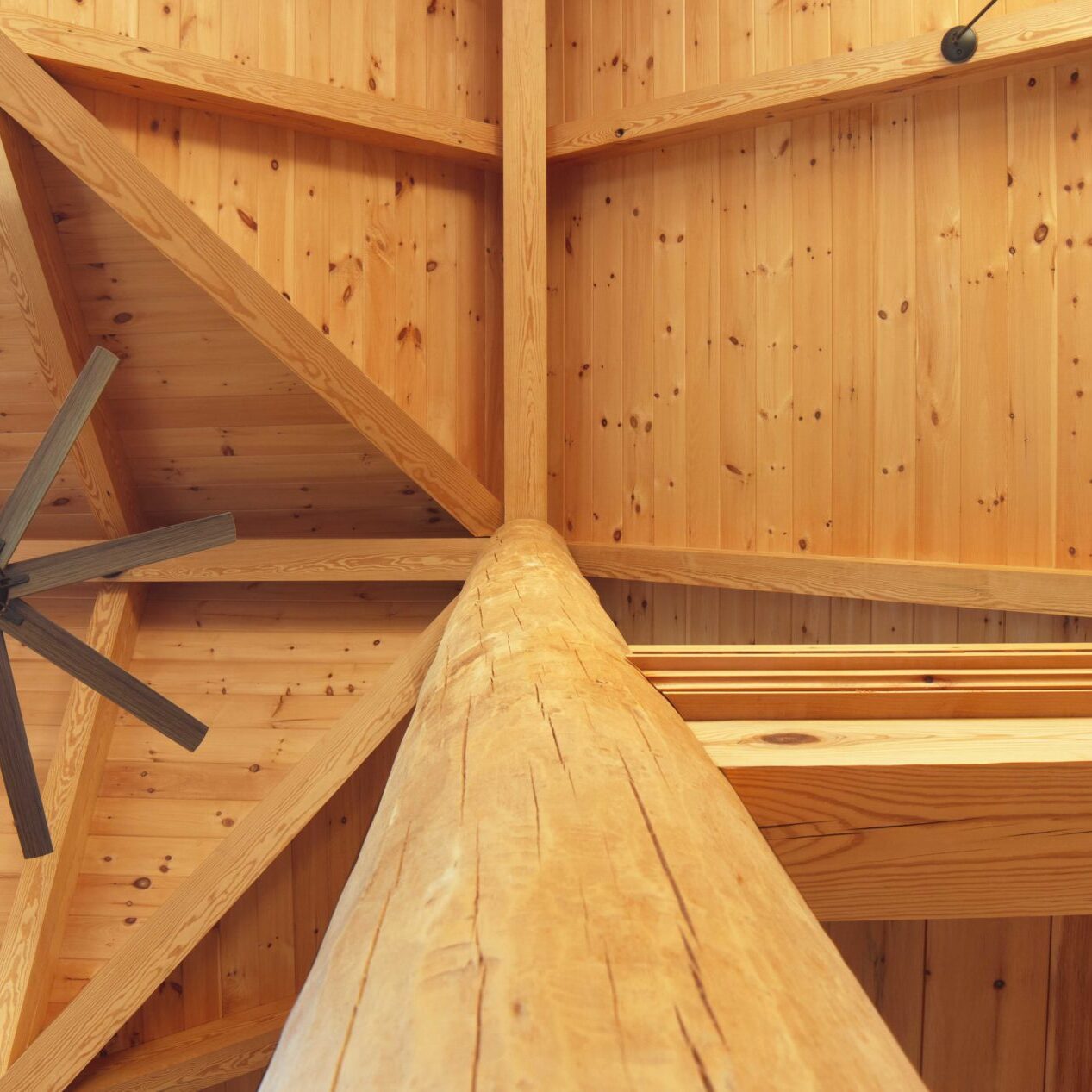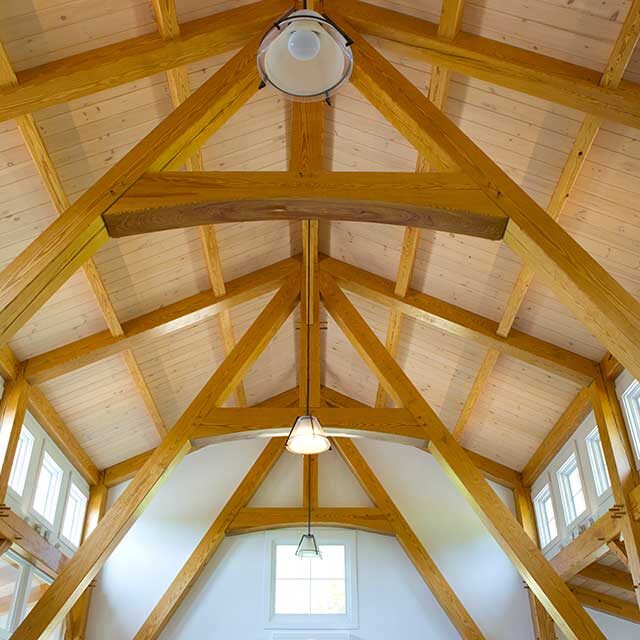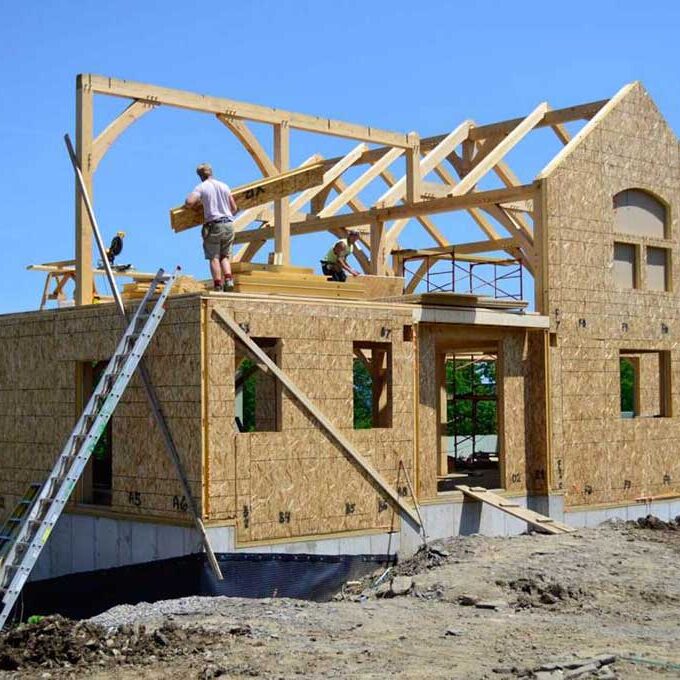Choosing a Wood Species
Woodhouse Products
There are a number of varieties of wood species to choose from that are suitable for your home, and each has its own strong points and weaknesses. You may also need to consider availability, sustainability, cost, and suitability in making this important decision.
Besides the typical timber species listed below, we also have crafted frames in hemlock, western red cedar, cypress, and other wood species. We have also used species like black walnut, mahogany, cherry, and others as accent pieces. If you desire a different species of wood, ask your Regional Project Manager about its suitability in timber framing
Douglas Fir
Douglas Fir
One of the most popular species to use for the frame is Douglas fir. It has a pleasant scent and ranges in color from warm pinks, oranges, and rusty reds. It grows fast, thick, and tall in the dense forests of the Pacific Northwest. These timbers can span 50 feet and support great loads. It’s a solid choice for large projects and mountain homes.
| Strength Characteristics | High bending strength to best accomplish long spans and support heavy loads with typical timber size |
| Size availability | The longest of the common species. Available up to 50 ft and in a very large cross section |
| Grain pattern | Generally tight, dense, straight subtle grain with few tight knots. |
| Color | Yellow-orange to darker reds with finish and UV exposure. |
| Checking / movement | Minimal amount of checking and movement as it dries. |
| Relative Cost | $$$ |
White Oak
White Oak
White Oak is common throughout the eastern and central United States. It is a slow growing tree that can reach truly impressive dimensions of 80–100ft tall. The timber is a light brown and grey color with fine grain. White oak has been prized for its high load bearing and water/rot-proof properties since the late 1700s, when it was identified as one of the best species for constructing ships. Those same characteristics now make it an ideal candidate for outdoor timber frame applications, like porches or pavilions.
| Strength Characteristics | Moderate bending strength to accomplish average spans and support heavy loads with typical timber size |
| Size availability | Longer lengths (over 20 ft.) and larger cross sections are more difficult and expensive to find. |
| Grain pattern | Subtle grain with occasional beautiful swirling knots |
| Color | Cream darkening to golden brown with finish and UV exposure. |
| Checking / movement | Moderate checking and some movement as it dries. |
| Relative Cost | $$$$ |
Red Oak
Red Oak
Red Oak spans the northern United States into Nova Scotia and is one of North America’s fastest-growing hardwoods. It checks and moves considerably as it dries over the first three to five years, but the elegant and warm colors of the timber make it a popular timber choice regardless. Red Oak is also a favorite wood for use in interior joinery, decorative veneers, wall paneling, millwork, and woodenware. Southern red oak is red, while northern species are lighter in color. All color variations smell equally pleasant.
| Strength Characteristics | Moderate bending strength to accomplish average spans and support heavy loads with typical timber size |
| Size availability | Longer lengths (over 20 ft.) and larger cross sections are more difficult and expensive to find. |
| Grain pattern | Pronounced open swirling grain with few knots. |
| Color | Generally light brown with some reds and pinks darkening to golden brown with finish and UV exposure. |
| Checking / movement | Significant checking and movement as it dries. |
| Relative Cost | $$$ |
Southern Yellow Pine
Southern Yellow Pine
These trees grow in the southern United States and are actually three separate species: Shortleaf, Slash, and Loblolly Pines. They share the same timber name as the harvested wood is remarkably similar on a microscopic level, with tight rings and grain patterns. All three species range in color from yellow to off-white. These trees also grow thick, tall, and fast, making them another popular choice for large projects.
| Strength Characteristics | High bending strength to best accomplish long spans and support heavy loads with typical timber size |
| Size availability | Generally second longest behind DF with lengths available up to 26 ft and in a large cross section |
| Grain pattern | Pronounced open swirling with some large, tight knots. |
| Color | Yellow darkening to yellow / amber with finish and UV exposure. |
| Checking / movement | Significant checking, twisting, and other movement as it dries. |
| Relative Cost | $ |
Eastern White Pine
Eastern White Pine
This species grows from Maine to northern Georgia and around the Great Lakes states. It is a blond wood with red streaking and large black knots that is commonly used in tongue and groove boards. It’s a plentiful species, but generally limited in length and size, making it a cost-effective choice for small and medium builds.
| Strength Characteristics | Lower bending strength requires increased timber size to accomplish average spans with heavy loads |
| Size availability | Not commonly found over 22 ft and is limited in cross section size |
| Grain pattern | Very subtle grain with large number of dark brown knots. |
| Color | White darketing to amber with finish and UV exposure. |
| Checking / movement | Moderate checking and little movement as it dries. |
| Relative Cost | $ |

Using Only the Top Grade in Timbers
Trees and lumber in general, are graded by appropriate grading agencies to ensure structural soundness. Woodhouse uses only number one grade or better in Douglas fir and southern yellow pine. The Woodhouse Douglas fir standard requires only dense growth, free-of-heart center (FOHC), number one or better appearance grade, and with no bark or wane. Douglas fir checks less; dense growth means less checking and twisting; number one or better provides straighter grain and fewer knots resulting in a better appearance. For red oak, white oak, and eastern white pine we typically use number two appearance grade.
Green vs Kiln Dried
Opting to use green timbers instead of kiln-dried reduces costs. Woodhouse timbers are typically green and are less expensive than kiln-dried. Kiln dried will shrink less, but in a timber frame the shrinking experienced by green wood can be beneficial for the joinery, as it tends to tighten the joints as the frame dries and shrinks. Woodhouse does supply kiln-dried timber in southern yellow pine as a standard option, and Douglas fir upon request.


"Housing" Joints
Woodhouse distinguishes itself with exceptional, tight-fitting joinery that is engineered to last centuries. Woodhouse “houses” all of its joints. Fully housed refers to timber frame joinery wherein a pocket is created in one timber to contain the entire end of another timber or frame member. Housing helps resist the twisting and checking of the housed member and hides gaps that can appear as the timbers shrink.
